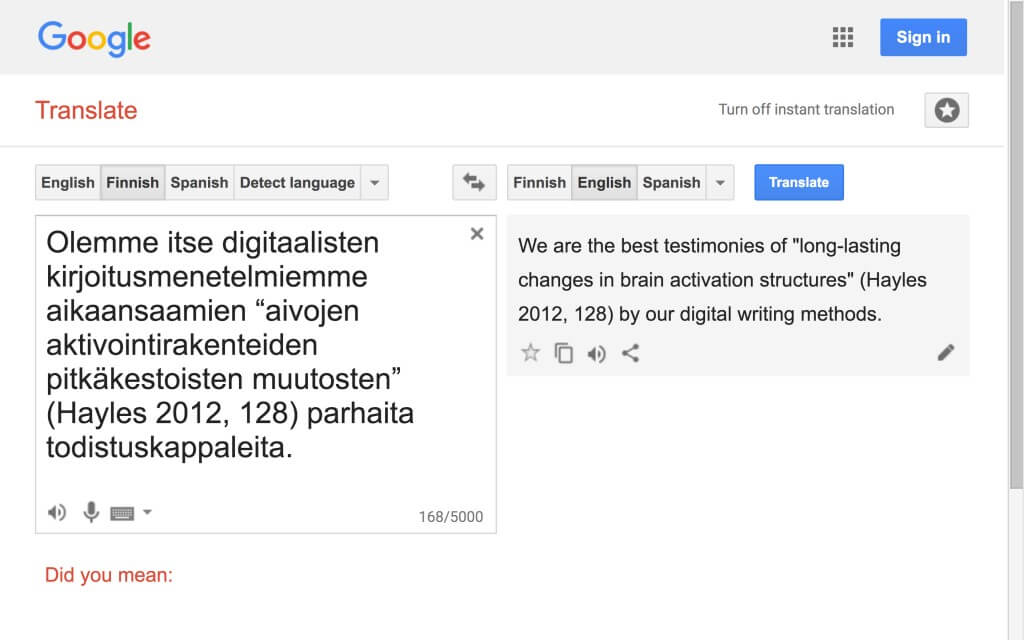3.9 Fragment 29
- Fragment 29, adapted from Hayles passage 19
What, then, happens when we step out of our writing machineries? When we disconnect ourselves from our technical system, do we, like the telegrapher in Hayles’s anecdote (see adapted from Hayles passage 19), interpret our environment as if we were still connected to our machines? What kind of spontaneous or instinctive—that is, in fact, automatic—translation or writing do our methods train or condition us to perform? Do we mimic the mechanisms of machine translation in our daily lives when we encounter ambiguous utterances or texts? In other words, how does the technogenic adaptation extend beyond its birthplace, in this case a performative setting, into the environment?
Essential to the anecdote that Hayles recounts and that DAR provocatively adapts in fragment 29 (3.9EN1) is what the telegrapher experiences when she ceases telegraphing. The technology continues to function in her body and through it, even though she is no longer expected to react to Morse code. Her body has taken on the task, hence the “long-lasting changes in brain activation patterns” Hayles makes reference to (see adapted from Hayles passage 19).
Hayles speaks of changes on a neural level that result in an individual becoming, at least temporarily, a human translation machine. It is tempting to look for similar extended reactivity, a sign of technogenetic adaptation, in connection with LW and WTCST. However, attempting to draw a parallel between the effects of receiving telegraph audio signals in exceptional circumstances and those of the long-term use of machine translation and speech recognition leads us to the limits of this research and to the limits of the concept of technogenesis itself.
Rather than attempting to demonstrate changes at a neural level, this artistic research has formulated questions that allow us to reflect on the writing methods dealt with here from the perspective of technogenesis. The telegrapher’s auditory experiences point to an overperformance of the nervous system, to an overcompensation. In the absence of the actual audio signals, she hears them in the ambient sounds of the environment. Based on my experience of LW and WTCST, I am convinced that similar extended responsiveness can be fostered by these practices. Whether or not this can be considered technogenesis, however, is the subject of further research.
While Hayles, in How We Think, fleshes out the concept of technogenesis by writing about, among other examples, the electrical telegraph, this artistic research departs from its artistic components. In and through them it approaches the hypothesis of the co-evolution of humans and technologies. Whereas Hayles can be regarded as seeking individual cases in support of a general theory, this artistic research has aimed to build theory on individual cases, i.e. the artistic parts. Regardless of whether this difference in academic approaches represents a more common contrast in the methods of scholars and artist-scholars, it has certainly been a significant factor in the dialogue realized in this thesis.
It is important to bear in mind that evolution proceeds very slowly, even if epigenetics compels us to re-evaluate our understanding of evolution. In other words, even if epigenetic changes were to accelerate the development of the human species as Hayles describes (Hayles 2012, 10–13), caution is in place when speaking of evolutionary changes. This research has been a decade in the making, which is a long time in artistic research and a blink of an eye in evolutionary terms. For this reason, even though digital media has undoubtedly confronted our nervous systems with new adaptive challenges and transformed our brains in subtle ways, examining the relationship of these changes and genetic code would exceed the limits of this project exponentially. However, it is important that we have pointed in the direction our findings indicate, even if the issue of technogenesis awaits further investigation.
For now, we might side with DAR that the research itself and its implementers are the best indicators of change. We have not turned into walking translation machines, but our exposure to machine translation and speech recognition has certainly affected our sensitivities. Similarly, digital media has radically altered this project as a whole, if its original starting point is taken as reference point (3.9EN2).
Notes
3.9EN1
Fragment 29 is provocative in many respects as it marks—after a sizable gap of seven fragments—a return to the normal rule of order, i.e., adapting directly corresponding Hayles passages. Even more strikingly, the Hayles passage adapted here is on page 128 of How We Think, while the previous one is on page 4 (see 3.2). At the latest, it is now clear that DAR has abandoned their intention to adapt every sentence in the Hayles book.
3.9EN2
I wrote my first artistic research plan in autumn 2006. The project, to be carried out in and through the writing of plays, was to explore autobiographical writing as a form of self-exploitation or selfploitation. An ABZ of Love was one of the artistic works described in the proposal. (Huopaniemi 2007)

